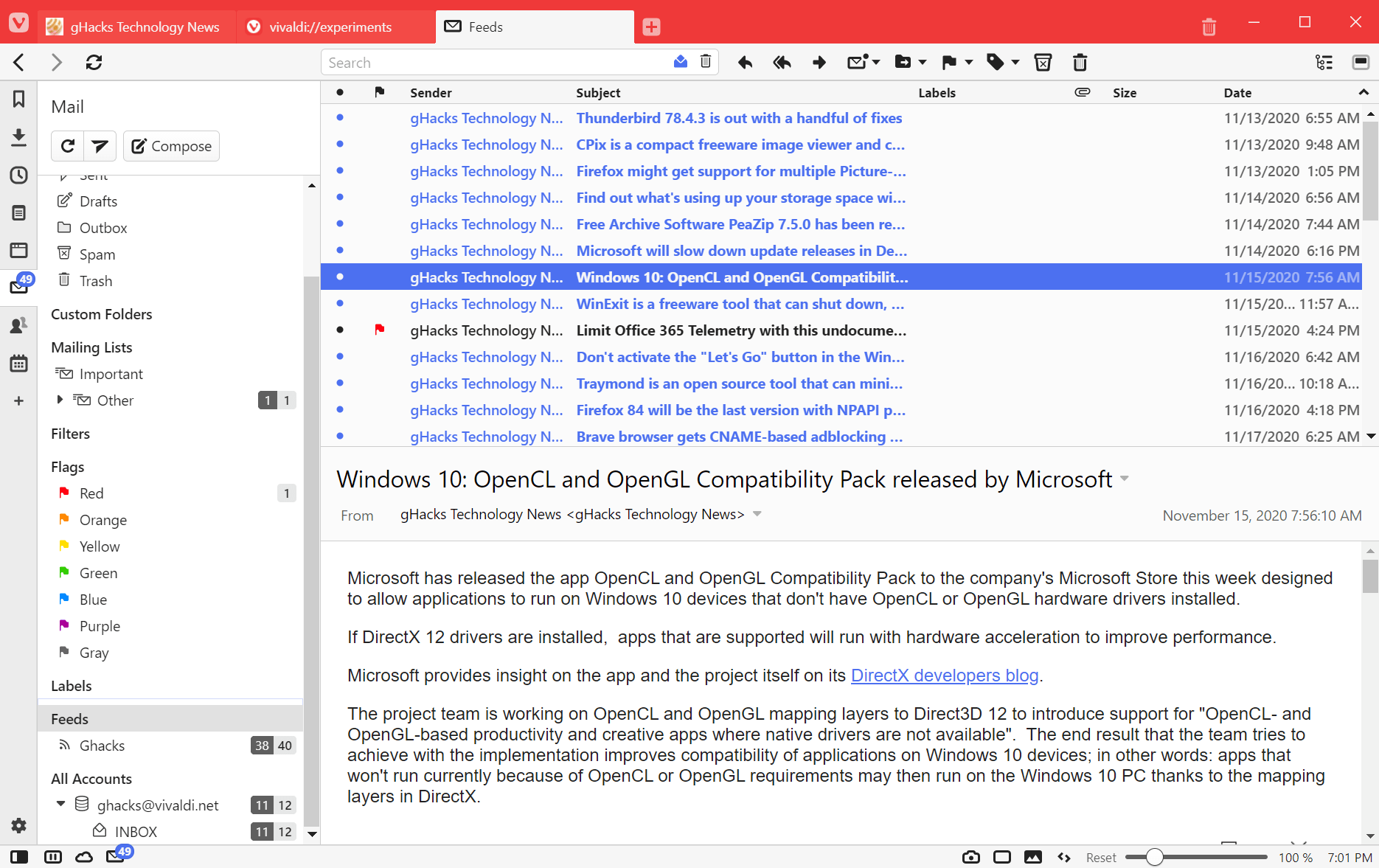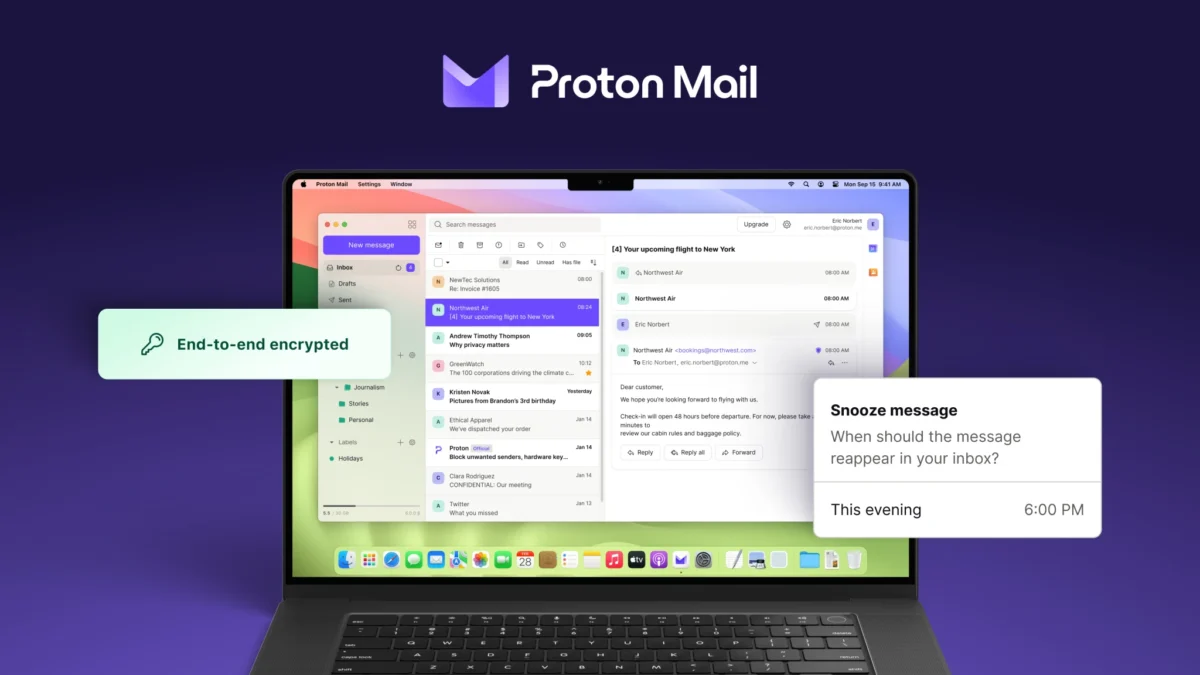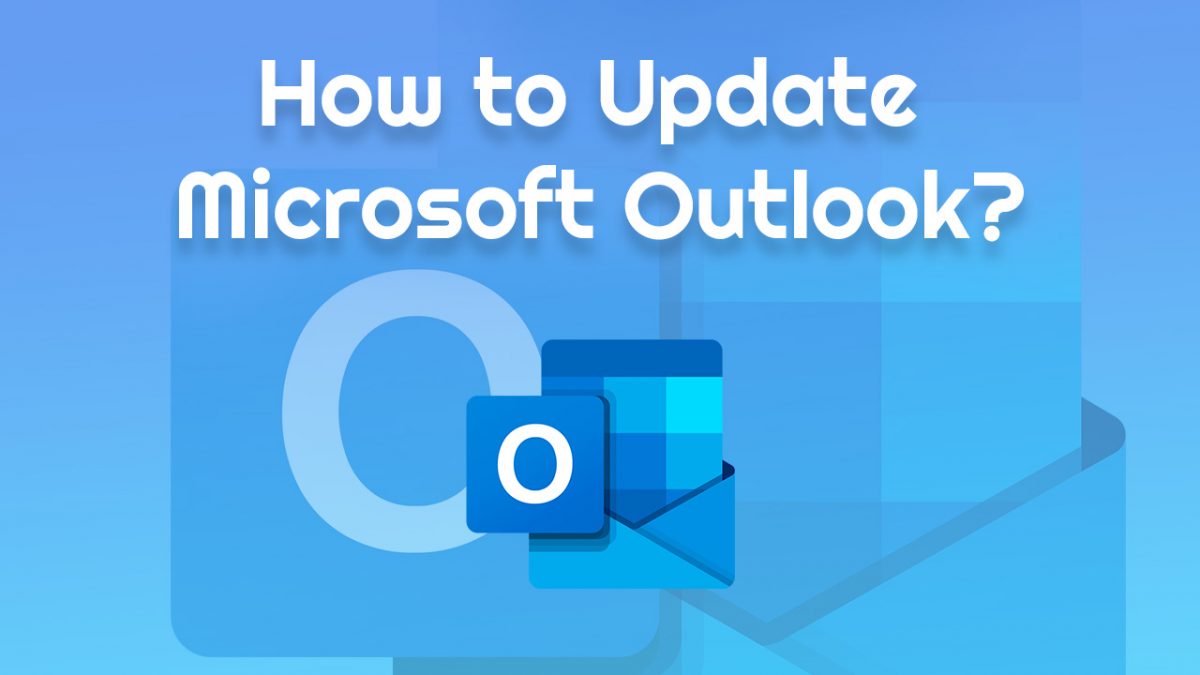Vivaldi Mail, Feed Reader and Calendar can now be tested

What a surprise. Vivaldi Technologies, maker of the highly customizable Vivaldi web browser, have released a first technical preview of the long awaited mail component. When we interviewed Vivaldi CEO Jon von Tetzchner in 2018, he revealed that Mail was something the company did work on to close another feature users liked about the classic Opera web browser.
Today, Vivaldi Technologies announced that Vivaldi Mail is ready for public testing. Launched as a technical preview, it is integrated into the latest snapshot of the Vivaldi web browser. Users need to enable the mail component manually for the time being to start using it.
Here is how you enable Vivaldi Mail right now:
- Load vivaldi://experiments/ in the address bar of the browser.
- Check the Calendar, Mail, Feeds experiment.
- Restart Vivaldi.
Select Mail from the sidebar panel and click on the button to add your first account. Adding an account is quite easy, all it takes most of the time is to enter the email address and in the second step the account password.
You do get a handful of options, e.g. to enable prefetch or add a sender name and signature.
The new component combines a mail client, a feed reader and a calendar. Vivaldi Mail supports IMAP and POP3, and that means that you can integrate any email client in Vivaldi Mail provided that it supports one of the two standards. The option to create a Vivaldi account and integrate it in Vivaldi Mail is also provided.
The mail component supports multiple email accounts that you can all add to the client, similarly to how you can add multiple accounts to Microsoft Outlook or Mozilla Thunderbird.

Vivaldi Mail uses a layout with three panes. The left sidebar, called the Mail panel, displays mail folders and accounts, and feeds. All mails of the selected folder are listed at the top and the selected mail is displayed at the bottom of the interface. Options to change the default view modes are provided, e.g. to switch to a horizontally split layout instead of the default three-columns layout.
You can toggle a lot of what is displayed by default to hide certain components; this is true for custom folders, mailing lists, Feeds, junk and trash buttons. Additionally, you may select to only display unread emails by default to better focus on these.
The Mail Panel displays unseen and unread counters for all folders that it displays; the difference between the two is that unseen refers to new emails that you have never seen before while unread refers to seen emails that you have not dealt with yet. In other words, unseen is the number for all new emails, unread for all emails that you have not marked as read yet.
Vivaldi Mail supports saving searches as filters; useful if you run the same search over and over again and want to speed things up a bit in the future. Labels are supported as well and they do get synced, even if you use a different client, e.g. Thunderbird, on another device.

Adding feeds is not as intuitive as it could be, as this can only be done in the Settings and not directly from the mail interface. Another thing that needs to be supported is the importing and exporting of OPML files so that users can migrate from another feed reader to Vivaldi Mail or export their feeds. Since it is a preview, it is possible that these smaller usability issues will get addressed in future versions.
The feed reader works really well and is easy to use. Some features of the mail component can be used here as well, e.g. to add flags to specific feed posts or labels.
The engineers have added keyboard shortcuts to Vivaldi Mail to speed up things for users who prefer to use the keyboard. You can reply with a tap on "R", forward emails with "F", mark emails "K" or entire threads "M" as read, or perma-delete emails with the shortcut Shift-M.
Another handy feature is that Vivaldi keeps track of the history so that you can go back and forth in mail folders using the history buttons.
Mails can be send right away, or you may queue them to bulk-send once you are done.
The calendar is the third and final component of Vivaldi Mail. It supports syncing through a Vivaldi account or any other CalDAV calender. Users may select to keep all the data local, but syncing is supported if required.
The calender supports a number of useful features including inline editing, simple creation of events, different layouts to view the data, a handy year overview option, full keyboard accessibility and more.
You can check out the very detailed blog post on the Vivaldi blog for additional details.
Closing Words
Vivaldi will be one of the few web browsers with a mail component once it launches in stable; this alone sets it apart from major browsers who don't offer these components. While you can add feed support via extensions to some, mail is not something that you may add using extensions.
The technical preview looks good already and it works fine. The feed reader is fast, but it needs a bit of work on the usability side, and it remains to be seen if it is capable of managing hundreds of feed subscriptions without performance issues.
All in all, it is a very promising start for Vivaldi Mail.
Now You: What is your first impression of Vivaldi Mail?























@Anonymous
What?!!… Did LibreOffice make that change, without AFAIK announcing it?
LibreOffice never had separately usable/downloadable modules when I was using it.
It looks great. If they can make a standalone version without the full browser. I hate that its attached to the side bar. So the only way to see your folders is when the sidebar is enabled.
Nice, I hope the calendar turns out well, since there currently isn’t a CalDAV capable calendar that I’m satisfied with (except on Android).
“Jack of all trades, master of none” comes to mind
The Opera M2 system.
Since moving from Opera after using it for a decade, I’ve be using extensions like Smart RSS to compensate.
https://github.com/SmartRSS/Smart-RSS
Some don’t like it, but some swore by it. I liked its utility and still do even though there was Google Reader and now Feedly.
This is a great development. There aren’t enough mail clients around, and Quite RSS is alone in its field.
If Vivaldi can apply to those functions the same creativity they have applied to the browser (tiling, notes, etc.), they have a winner.
Microsoft Outlook is expensive, cloudy and non-private, and Thunderbird is clunky, weird and tied to Firefox — which is a lost cause.
Oh no, not more BLOAT!
This is what killed Opera for mainstream use(the M2 mail client).
Doesn’t Jon ever learn from experience?
The icon-only UI without any text labels and dark glyph icons makes my cringe. Zero on ease of use. I need easy to understand text labels for every button and some color in the icons before I can consider it usable.
This is an expected addition to vivaldi as no doubt all opera users crossed over to vivaldi.
I think it would be safe to say this is what you would call an internet suite pretty much like seamonkey.
Personally i have no need for an inbrowser mail client but it is a welcome addition for former opera users.
I’m no longer interested in the “Vivaldi Technologies” project.
Since the first release of the browser, I have been actively using the browser and posted “issues” on the community forums.
The community was very friendly to the users, responded quickly and accepted all of the suggestions.
However, Because they are accepting all of the proposals, as a result bloated with “niche capabilities”, the user experience has decreased. As it got worse with each version, I was only frustrated and reached the limit of patience.
Anyway, the UI, functions, and performance did not reach my acceptable level, so I broke up with “Vivaldi” last June.
So, I have owned the email account “@vivaldi.net”.
When it comes to email clients, “Thunderbird” is my unwavering favorite. Blessed with useful extensions, I am happy with the performance and stability.
I check “RSS subscription” in Thunderbird, and as a result, I using it more frequently than the browser.
My current situation:
Thunderbird 78.5.0 (64-bit) / Windows_NT 10.0
Extensions (addons.thunderbird.net) :
*cloud – FileLink for Nextcloud and ownCloud
Auto Address Cleaner T
Automatic Dictionary
Birthday Calendar
BorderColors D
CardBook
Check and Send
Colored Diffs
Compact Headers
Config Button
Copy Message ID
Darko
DeepL selected text
Empty Folder
Enigmail
FileLink Provider for Box
Folder Pane View Switcher
Full Address column
Identity Chooser
LookOut (fix version)
Mail Merge
Manually sort folders
Minimize on Close
No Message Pane Sort
Previous Colors
Quicktext
Quote Colors
Remove Duplicate Messages
Restart Button
ScrollAnywhere
Signature Switch
Spam Scores
Tag Popup
TbSync
ThirdStats
Thunderbird Conversations
Web Translate
XNote++
Thunderbird is my main email and RSS reader as well, but Thunderbird is really lacking decent RSS subscription management.
I prefer to have my RSS feeds displayed separately in the folder pane. But the only way to do this is to create a new subfolder for each RSS feed from the folder pane. You cannot create subfolders anywhere else.
When adding a new feed under “Manage feed subscriptions,” I have to select the subfolder I created so the feed will be housed there. This workflow is really awkward. I wish Thunderbird made this easier, but I’ve learned to live with its quirks.
Wow. Just wow. So, Thunderbird is actually a do-it-yourself program, and you have to add dozens of extensions to make it work properly.
You have an extension to minimise on close, and you have another to empty folders. Do you have an extension to quit the program ?
My Microsoft Outlook 2003 doesn’t have no stinking extensions. It’s been properly designed from the get-go. And I have very few extensions added to Vivaldi, which is my unique browser.
@Clairvaux,
Wow. Just wow. So, Thunderbird have to add dozens of extensions to make it work properly.
My Microsoft Outlook 2003 doesn’t have no stinking extensions. It’s been properly designed from the get-go. And I have very few extensions added to Vivaldi, which is my unique browser.
I laughed at your unique comment!
In other words, you are a person who is happy with the “Meals distributed”
I am the type who selects meals a la carte and also specify wine.
Namely, the values ​​are different.
Pledge allegiance to “Microsoft”, which is fraudulent and exploits user privacy, and “Vivaldi”, who can never make progress.
Good luck!
Wow, what a clueless reply from beginning to end. As with anything extensions are optional and the example you give “minimize on close” obviously overrides the normal behaviour of the majority of apps when you exit.
Looks like Opera M2.
I already see the development in this case: they will support him for a couple of years and then they will leave him. Then a break for a couple of years and then all over again! I need a serious email client…
And yes, it is not a separate, standalone email client…
What a treat! I, for one, am glad to see this in Vivaldi!
What are this company’s primary sources of revenue?
Are they just another Brave, making money off of people by pushing advertising on them? Or are they better?
@Ted
> Are they just another Brave, making money off of people by pushing advertising on them? Or are they better?
Do you mean Brave’s opt-in(!!!) ads that allow users to earn a share of the revenue or donate it to their favorite websites? LOL. Brave users don’t have to use this, at all. I appreciate that they (Brave Software) try to sustain themselves without profiling people (Google, Microsoft) or by being financially dependent on the data kraken (Mozilla).
To answer your question, Vivaldi funds itself via search engine royalties and by promoting select pages on the New Tab Page. However, I believe they are losing money so far.
@Ted
Vivaldi makes money from sponsored bookmarks upon initial install and search engine deals with Bing, DDG, Ecosia, & Startpage.
I can’t speak to the financial health of the company, they seem to be living off the money the creators got when they were at Opera. I believe Vivaldi has stated they need 5 million users to turn a profit, the last figure they released had them at 1.5 million users.
What would you suggest they do to earn money? You can check out this official post about the business model:
https://vivaldi.com/blog/vivaldi-business-model/
In a nutshell: partner deals with search engines and bookmark partners.
Very nice feed reader! The only bad thing is Vivaldi is becoming heavier every update..
I hope there’s option to install what feature you wanted just like LibreOffice which allows you to install only Writer or Calc.
@Anonymous
What?!!… Did LibreOffice make that change, without AFAIK announcing it?
LibreOffice never had separately usable/downloadable modules when I was using it.
How’s the memory usage when using the new Mail component, Martin?
Opera Presto remains one of my favorite browsers of all-time. The integrated mail client and feed reader was always one of my favorite aspects of the browser and it was always optimized and lean.
Vivaldi, on the other hand, was very memory-hungry when I last tried it a few years ago. Would be interested in giving their latest version a try once M3 is out of technical preview.
I cannot really say at this point, it surely is going up, but the real benchmark is when you use it to manage multiple accounts with thousands of messages or hundreds of feeds.
I have about 350 Megabytes of RAM with Ghacks open, a minor email account open, and the Ghacks feed. This may go down to about 300 Megabytes after a while.
Recently for the N-th time tried to use Vivaldi as my main browser, lasted a week or two before giving up.
Performance on websites is abysmal as it has been since 2015 when I first found out about it. The UI itself struggles. My PC can run Death Stranding maxed out for reference, so hardware is not an issue.
I see the keep adding more bloat to the browser and ignoring problems or usable features and instead implementing useless features. How before they bundle a full-fledged OS running inside the browser as a virtual machine that’s been used by 3 people from their entire userbase?
In comparison Brave as the other popular Chromium-based alternative has not been adding any bloat and has attracted a lot more users. As for Vivaldi? Do they even have 1000 worldwide users?
@Allwynd
But can it run Crysis Remastered???
@Allwynd
Brave and Vivaldi cater to different segments of the market.
Brave: privacy, easy to use adblocking (especially on mobile)
Vivaldi: power users, customization
Brave serves as a drop-in replacement for Chrome adding the stuff most people want yet Google refuses to include. I’d say this is likely to attract a greater number of users, the power user niche is just a bit smaller, or so it seems. That being said, I’d like to see both projects succeed.
@Iron Heart
If Vivaldi is about customization why can’t I customize how it handles downloads? There is only one way to do that – the sidebar. You’re forced to either keep the status bar on the bottom to have that handy sidebar button at the ready or use the F4 key to bring up the side bar each time you want to do something with downloads.
I’ve suggested them back in 2015 to add different methods, like the pop up window in Opera and Firefox or that bar Chrome and Brave have when something is downloaded, it’s way more handy than the Vivaldi sidebar.
I don’t think the browser is that good even for customization.
@Allwynd
Ah yes, that’s true. I remember the side bar being a very clunky way of handling things when I briefly tried out Vivaldi. They should most definitely offer alternative download UIs. You have done all that was immediately possible by suggesting alternative solutions to them, if they don’t listen, then that’s that. Another browser would then be the best option.
I do like their concept, however I think they need to focus on more limited areas, wildly adding customization options left and right can lead to important things being left in the dust, ironically.
Yes, they say it is customizable BUT only in their definition of customizability. It is missing a lot features that are actually needed but they add a game to their browsers instead; bloating it in every way possible. The browser also seems to see the performance as an afterthought or care about it at all as it runs really slow on my PC.
One has to wonder at the level of maturity of people who regard the features they desire as “actually needed,” while classing the features other people desire as “bloat.”
@Purgat0ri
+1
@Purgat0ri
OK, so you think including a game with a freaking web browser, or Philips Hue within that browser, is something many people want or need? Same with the Mail client, if that were such a popular demand, I’d guess SeaMonkey would not be <1% market share, right?
Also, if you have limited resources, you have to focus on limited areas of improvement also. This needs no further explanation, or does it? Every business out there needs at least some kind of planning ahead.
It is you who needs to grow up if you think that a company with ca. 50 employees can fulfill every whim and wish. It's just not possible outside of utopia land.
@Iron Heart
Serious man-hours were not devoted to Philips Hue OR the built-in game. I don’t use either one of those features, but it’s no skin off my nose if they’re there.
As for the mail client, it has been a popular demand among a sizeable proportion of Vivaldi’s admittedly-niche audience: but that is a niche that Vivaldi have decided to concentrate on appealing to. It’s also consistent with a feature set that has sought to decrease the user’s dependency on data-siphoning web apps & endless searches: e.g., equipping with powerful bookmark & history features so that they don’t have to re-find what they’re looking for by submitting another query to Daddy Google, and the mail client allows for the user to set up multiple accounts and avoid web-app front-ends. Said mail client also comes with an RSS reader/podcast player, which again allows the user to keep tabs on sources they curate themselves, rather than, again, relying Twitter and Facebook to serve up information using targeted algorithms.
Also, the mail client has been planned since Vivald’s inception, and it was developed by a separate team. I’m not sure where you get the notion that Vivaldi have forsaken any sort of planning—maybe you just don’t know what you’re talking about?
Vivaldi is about putting control in the hands of the user, and I think that the majority of features and options which they have included up to this point serve that end quite nicely. And while I have no particular interest in deconstructing your silly strawman about catering to the whims of every user with a team of 50 employees, I will concede that I have misgivings about their ability to fulfil their mission, or to even remain viable into the future since I do not see that they are on a path to ever reaching profitability. I wish that they enjoyed the same success that Brave has seen this year or that, better yet, they were one-in-the-same project, but I also do not think that abandoning what makes them unique in order to become just another Chrome clone would be a worthwhile endeavour—we have enough of those already.
@Purgatori
I think eventually Vivaldi is going to need to choose if they can continue to prioritize new features or if they prioritize keeping up with the latest Chrome releases. It seems that the latter represents a continual challenge for the company and their small development team. While I doubt users would react well to running an older version of Chromium, trying to keep up with the changes that Google & Microsoft make to the Chromium base seems to present a unique challenge for the Vivaldi team due to the heavy customization layer they add to Chromium.
Brave is also not immune to that struggle, but they also are not adding layers of custom CSS on top of Chromium, have a larger dev team, and have the financial resources to add employees due to substantial user growth. I would be stunned if Vivaldi even comes close to 2 million users by the end of 2020.
@Mike W I totally agree, and that’s why I’m not as optimistic about the future of Vivaldi as I’d like to be. Given the onerous task of keeping up with Chromium and fixing the constant breakages that occur with each version bump, I’m surprised they have made it as far as they have, really.
@T
Yes, I agree. The game was definitely bloat, and so is their Philips Hue integration (if you ask me). They definitely need to limit their focus on select areas of improvement, adding bloat and also real customization option with no greater concept / plan going forward will lead nowhere, I feel.
The CEO of Vivaldi said in an interview late 2019/early 2020 that they had 1.5 million users. They have a small, but devoted fan base and I could see them pulling in tech enthusiasts. Vivaldi will never be mainstream, it’s just too “busy†and different than Chrome, Firefox, Edge, Safari, etc.
I try Vivaldi out a couple times a year, but the persistent bugs and half-baked features always leads me to uninstalling it after a week or so. Love the message of Vivaldi, hate the execution.
It looks like Opera 12.x A LOT ! Great news 😃
Zawinski’s Law strikes again: Every program attempts to expand until it can read mail.
This is going to be the “talk of the town” for a while now.
Thank you Martin for the report and thank you Vivaldi for making such huge steps!